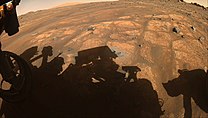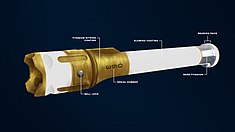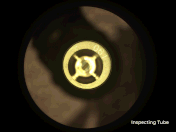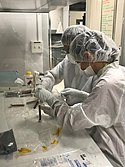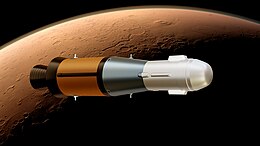火星样本取回任务

火星样本取回任务(Mars sample-return mission, MSR)是一项计划并部分执行中的采样返回任务,旨在收集火星上的岩石和尘埃样本并将其送回地球进行更加广泛的分析。[1][2]
目前主要的计划提案有美国国家航空暨太空总署(NASA)和欧洲太空总署(ESA)合作的任务、中国国家航天局(CNSA)的天问三号以及俄罗斯国家航太集团(Roscosmos)的火星 - 土壤(Mars-Grunt)任务。截至 2022 年,NASA - ESA 计划仍处于设计阶段,但毅力号火星漫游车目前已经在火星上收集样本。
科学价值
[编辑]
将样本送回地球后,可以进行比火星漫游车上的仪器更加详细的分析。NASA 总部科学副署长托马斯·祖布臣(Thomas Zurbuchen)预计,此研究将在许多领域取得多项新发现。[3]将来也可能会使用目前尚不存在或研发中的的仪器分析样本。[4]
2006 年,火星探测计划分析小组确定了 55 项与火星探测有关的重要调查。 2008 年时,他们得出的结论是:大约一半的调查“可以在某种程度上由火星样本取回任务解决”,使火星样本取回任务成为“在整个调查清单中取得最大进展的单一任务”。 此外,据报导,如果没有返回样本,很大一部分调查就无法有意义地推进。[5]
此外,火星样本的其中一个来源是火星陨石,它们是从火星喷出并进入地球的岩石。 截至 2019 年 4 月,在 61,000 多颗已知陨石中,有 266 颗陨石被确定为火星陨石。[6]这些陨石被认为来自火星,是因为它们的元素和同位素组成类似于在火星上分析的岩石和大气气体。[7]
历史
[编辑]
三十年以来,科学家一直希望能从火星采回地质样本。[8]早期的概念之一是火星调查样本收集 (SCIM) 提案,该提案涉将发送探测器在掠过火星上层大气的过程中收集尘埃和空气样本,而无需着陆或绕轨。[9]
苏联在 1975 年考虑了火星样本返回任务 Mars 5NM,但由于发射它的N1火箭一再失败,该任务被取消。计划于 1979 年进行的另一项样本返回任务 Mars 5M(Mars-79)也因复杂性和技术问题而被取消。[10] 美国的火星探索计划是在 1993 年 9 月火星观察者号失败后成立的,他们支持研发取回火星样本的任务。[11]
1996 年,人们认为在火星陨石ALH84001中发现了明显的微化石,提出了火星上存在生命的可能性。 这一假设最终被否决,但重新引起了人们对火星样本返回的兴趣。[12] 2006 年年中,国际火星探测工作组 (IMEWG) 授权成立国际火星样本返回架构 (iMARS) 工作组,以概述国际赞助和执行的火星样本返回任务的科学和工程要求。[5]
NASA 的火星探索计划曾考虑在 2008 年之前返回样本的任务概念,[13]但在计划审查后被取消。[14] 2001 年夏天,喷气推进实验室 (JPL) 向行业领导的团队(波音、洛克希德马丁和 TRW)请求任务概念和建议。之后也向某些大学航空工程系(麻省理工学院和密歇根大学)提出了类似的请求。2009 年 10 月,NASA 和 ESA 建立了火星探索联合倡议,以推进 ExoMars 计划,其最终目标是“在 2020 年代从火星返回样本”。 [15][16] ExoMars 的第一个任务计划于 2018 年发射[4][17],后续的任务是在 2020-2022 年的时间范围内返回样本。[18] 但在2011 年取消缓存漫游车 MAX-C,后来 NASA 由于预算限制从 ExoMars 撤出,结束了任务。[19]
2011 年初,美国国家研究委员会的行星科学十年调查制定了 2013-2022 年期间的任务规划优先事项,宣布火星样本取回任务是该期间最优先的旗舰任务。[20] 2012 年 9 月,NASA 宣布进一步研究将火星样本带到地球的几种策略最早于 2018 年开始执行任务。[21][22] 2018 年 7 月,NASA与空中客车公司签订合约,以生产“捡取样本火星漫游车”。 2018 年 4 月,NASA 和 ESA 签署了一份同意书,该同意书可能为火星样本返回任务提供基础。[23][24] 2019 年 7 月,提出了一种任务架构。[25][26] 2020 年 4 月,提出了任务的更新版本。.[27]
2022 年 7 月 27 日,NASA 宣布任务中将不发射捡取样本火星漫游车,而使用随样本取回着陆器登陆火星,以机智号为原型的样本回收直升机。[28]
火星2020的毅力号火星漫游车任务中的其中一个关键目标是为火星样本取回任务做准备。[29][30][22]毅力号于 2021 年 2 月 18 日降落在杰泽罗撞击坑,它将收集样本并将其储存在 43 个样本管中,以备日后取回。
计划
[编辑]NASA - ESA
[编辑]NASA-ESA 计划将使用三个任务取回样本:[31] [32] [33]
- 样本采集任务(毅力号)
- 样本收集任务(样本收集着陆器(Sample Retrieval Lander, SRL)+ 火星上升飞行器(Mars ascent vehicl, MAV) + 样本转移机械手臂 + 2 架机智号级样本回收直升机)
- 返回任务(地球返回轨道器(Earth Return Orbiter, ERO))。
该任务希望了解火星是否曾孕育生命。
中国
[编辑]中国国家航天局正计划在2028至2031年间实施名为天问三号的火星样本返回任务[34][35]。[36] 2021 年通过了一项计划,该计划建议通过一个样本收集着陆器和一个火星上升飞行器来检索样本。该任务将于 2028 年 11 月用长征三号乙发射。样本将通过地球返回轨道器发送到地球并转移到再入舱,这两个探测器都将在 2028 年 11 月用长征五号发射,并于 2031 年 9 月返回地球。[37][38]
法国
[编辑]多年来,法国一直致力于样本取回。这包括用于返回样本的外星样本管理设施的概念,以及许多提案。[39]他们致力于开发火星样本返回轨道器,作为与其他国家联合任务的一部分,该轨道器将捕获并返回样本。
日本
[编辑]2015 年 6 月 9 日,日本宇宙航空研究开发机构 (JAXA) 公布了一项名为火星卫星探测器 (MMX) 的计划,以从火卫一或火卫二取回样本。[40][41]火卫一的轨道离火星更近,它的表面可能已经捕获了火星的粒子。[42]探测器计划于 2024 年 9 月从地球发射,并于 2029 年返回地球。[43]日本积极参与国际火星样本取回任务。
俄罗斯
[编辑]俄罗斯火星样本返回任务的概念是火星-土壤任务。[44][45][46][47][48] 它将采用福布斯-土壤的设计。[45] 包括一个轨道器和一个着陆器(但没有移动能力),[49]着陆器将使用机械臂从着陆器周围收集样本。[44][50]
NASA - ESA 计划图集
[编辑](File:Mars2020Rover-SampleCollectionStorage-20200206.webm)
参见
[编辑]参考资料
[编辑]- ^ Chang, Kenneth. Bringing Mars Rocks to Earth: Our Greatest Interplanetary Circus Act - NASA and the European Space Agency plan to toss rocks from one spacecraft to another before the samples finally land on Earth in 2031. The New York Times. 28 July 2020 [28 July 2020]. (原始内容存档于2020-12-01).
- ^ Treiman, et al. – Groundbreaking Sample Return from Mars: The Next Giant Leap in Understanding the Red Planet (PDF). [2022-05-23]. (原始内容 (PDF)存档于2016-06-10).
- ^ NASA's Perseverance Rover Collects First Mars Rock Sample. NASA. September 6, 2021 [March 29, 2022]. (原始内容存档于2022-06-01).
- ^ 4.0 4.1 Mars Sample-Return 互联网档案馆的存档,存档日期2008-05-18. NASA Accessed 2008-05-26
 本文含有此来源中属于公有领域的内容。
本文含有此来源中属于公有领域的内容。
- ^ 5.0 5.1 e International Mars Architecture for the Return of Samples (iMARS) Working Group. Preliminary Planning for an International Mars Sample Return Mission (PDF). NASA. June 1, 2008 [29 August 2021]. (原始内容 (PDF)存档于2022-05-23).
- ^ Meteoritical Bulletin: Search the Database. lpi.usra.edu. [2020-08-21]. (原始内容存档于2020-10-06).
- ^ Treiman, A.H. The SNC meteorites are from Mars. Planetary and Space Science. October 2000, 48 (12–14): 1213–1230. Bibcode:2000P&SS...48.1213T. doi:10.1016/S0032-0633(00)00105-7.
- ^ Space Studies Board; National Research Council. Vision and Voyages for Planetary Science in the Decade 2013–2022. National Academies Press. NASA: 6‑21. 2011.
 本文含有此来源中属于公有领域的内容。
本文含有此来源中属于公有领域的内容。
- ^ Jones, S.M.; et al. Ground Truth From Mars (2008) – Mars Sample Return at 6 Kilometers per Second: Practical, Low Cost, Low Risk, and Ready. Universities Space Research Association (USRA). 2008 [September 30, 2012].
- ^ Harvey, Brian. Russian Planetary Exploration: History, Development, Legacy and Prospects. Springer Science & Business Media. 2007: 238 [2022-05-23]. ISBN 978-0-387-46343-8. (原始内容存档于2022-06-01).
- ^ Shirley, Donna. Mars Exploration Program Strategy: 1995–2020 (PDF). NASA (JPL). [18 October 2012].
 本文含有此来源中属于公有领域的内容。
本文含有此来源中属于公有领域的内容。
- ^ Mars Program Gears up for Sample Return Mission. NASA. [2022-05-23]. (原始内容存档于2021-06-21).
 本文含有此来源中属于公有领域的内容。
本文含有此来源中属于公有领域的内容。
- ^ Newcott, William. Return to Mars. National Geographic Magazine. 1998-08-01.
- ^ MarsNews.com :: Mars Sample Return. 27 February 2015. (原始内容存档于27 February 2015).
- ^ NASA and ESA Establish a Mars Exploration Joint Initiative. NASA. 8 July 2009 [2022-05-23]. (原始内容存档于2009-10-28).
 本文含有此来源中属于公有领域的内容。
本文含有此来源中属于公有领域的内容。
- ^ Christensen, Phil. Planetary Science Decadal Survey: MSR Lander Mission. JPL. NASA. April 2010 [2012-08-24].
 本文含有此来源中属于公有领域的内容。
本文含有此来源中属于公有领域的内容。
- ^ BBC – Science/Nature – Date set for Mars sample mission. 2008-07-10 [2022-05-23]. (原始内容存档于2020-10-13).
- ^ Mars Sample Return: bridging robotic and human exploration. European Space Agency. 21 July 2008 [2008-11-18]. (原始内容存档于2012-10-07).
- ^ International cooperation called key to planet exploration. NBC News. 22 August 2012 [2022-05-23]. (原始内容存档于2020-09-24).
- ^ - EXPLORING OUR SOLAR SYSTEM: THE ASTEROIDS ACT AS A KEY STEP. www.govinfo.gov. [2022-05-23]. (原始内容存档于2022-03-01).
- ^ Wall, Mike. Bringing Pieces of Mars to Earth: How NASA Will Do It. Space.com. September 27, 2012 [2022-05-23]. (原始内容存档于2022-05-23).
- ^ 22.0 22.1 Mattingly, Richard. Mission Concept Study: Planetary Science Decadal Survey – MSR Orbiter Mission (Including Mars Returned Sample Handling) (PDF). NASA. March 2010 [2022-05-23]. 原始内容存档于2015-09-29.
 本文含有此来源中属于公有领域的内容。
本文含有此来源中属于公有领域的内容。
- ^ Rincon, Paul. Space agencies intent on mission to deliver Mars rocks to Earth. BBC. 26 April 2018 [2022-05-23]. (原始内容存档于2022-05-31).
- ^ Video (02:22) – Bringing Mars Back To Earth. NASA. 26 April 2018. (原始内容存档于2021-12-22).
 本文含有此来源中属于公有领域的内容。
本文含有此来源中属于公有领域的内容。
- ^ Foust, Jeff. Mars sample return mission plans begin to take shape. SpaceNews. 28 July 2019.
- ^ Cowart, Justin. NASA, ESA Officials Outline Latest Mars Sample Return Plans. The Planetary Society. 13 August 2019 [2022-05-23]. (原始内容存档于2019-12-06).
- ^ Clark, Stephen. NASA narrows design for rocket to launch samples off of Mars. Spaceflight Now. 20 April 2020 [21 April 2020]. (原始内容存档于2020-12-01).
- ^ NASA Will Inspire World When It Returns Mars Samples to Earth in 2033. NASA mars exploration program. 2022-07-27 [2022-09-18]. (原始内容存档于2022-10-11).
- ^ Foust, Jeff. Mars 2020 rover mission to cost more than US$2 billion. SpaceNews. 20 July 2016.
- ^ Evans, Kim. NASA Eyes Sample-Return Capability for Post-2020 Mars Orbiter. Denver Museum of Nature and Science. 13 October 2015 [10 November 2015]. (原始内容存档于31 August 2017).
- ^ Foust, Jeff. NASA to delay Mars Sample Return, switch to dual-lander approach. SpaceNews. 27 March 2022 [28 March 2022].
- ^ Future Planetary Exploration: New Mars Sample Return Plan. 8 December 2009 [2022-05-23]. (原始内容存档于2022-03-31).
- ^ Mars sample return. www.esa.int. [2022-01-03]. (原始内容存档于2022-07-02) (英语).
- ^ China considers more Mars probes before 2030. news.xinhuanet.com. 10 October 2012 [2022-05-23]. (原始内容存档于2017-03-01).
- ^ Writers Beijing (AFP). China to collect samples from Mars by 2030: Xinhua. marsdaily.com. 10 October 2012 [2022-05-23]. (原始内容存档于2022-03-20).
- ^ Andrew Jones published. China to launch Tianwen 2 asteroid-sampling mission in 2025. Space.com. 2022-05-18 [2022-05-20]. (原始内容存档于2022-07-03) (英语).
- ^ @EL2squirrel. China's second Mars exploration mission is a Mars Sample Return mission: Earth Return Orbiter will be launched in 2028, another launch for Lander&Ascender, Earth Entry Vehicle will be return in 2031 pbs.twimg.com/media/ELo1S31UYAAcbMf?format=jpg&name=large (推文). 12 December 2019 –通过Twitter.
- ^ China is planning a complex Mars sample return mission. SpaceNews. 4 November 2021.
- ^ Counil, J.; Bonneville, R.; Rocard, F. The french involvement in Mars sample-return program. 34th COSPAR Scientific Assembly. 1 January 2002, 34: 3166. Bibcode:2002cosp...34E3166C –通过NASA ADS.
 本文含有此来源中属于公有领域的内容。
本文含有此来源中属于公有领域的内容。
- ^ JAXA plans probe to bring back samples from moons of Mars. The Japan Times Online. 10 June 2015 [2022-05-23]. (原始内容存档于2019-04-24).
- ^ Torishima, Shinya. JAXAの「火星の衛星からのサンプル・リターン」計画とは. Mynavi News. June 19, 2015 [2015-10-06]. (原始内容存档于2016-12-02) (日语).
- ^ 火星衛星の砂回収へ JAXA「フォボス」に探査機. The Nikkei. September 22, 2017 [2018-07-20]. (原始内容存档于2022-05-23) (日语).
- ^ MMX Homepage (English version) (页面存档备份,存于互联网档案馆) JAXA 2017
- ^ 44.0 44.1 Roscosmos – Space missions[失效链接] Published by The Space Review (page 9) on 2010
- ^ 45.0 45.1 Dwayne A. Day, November 28, 2011. 'Red Planet blues (Monday, November 28, 2011). The Space Review. 2011-11-28 [2012-01-16]. (原始内容存档于2012-04-19).
- ^ Kramnik, Ilya. Russia takes a two-pronged approach to space exploration. Russia & India Report. April 18, 2012 [2012-04-18]. (原始内容存档于2012-04-22).
- ^ Russia To Study Martian Moons Once Again (页面存档备份,存于互联网档案馆), Mars Daily, July 15, 2008.
- ^ Major provisions of the Russian Federal Space Program for 2006–2015 (页面存档备份,存于互联网档案馆), "1 spacecraft for Mars research and delivery of Martian soil to the Earth"
- ^ Brian Harvey; Olga Zakutnyaya. Russian Space Probes: Scientific Discoveries and Future Missions. Springer Science & Business Media. 2011: 475 [2022-05-23]. ISBN 978-1-4419-8150-9. (原始内容存档于2022-05-23).
- ^ ExoMars to pave the way for soil sample return. russianspaceweb.com. [2022-05-23]. (原始内容存档于2015-09-18).
- ^ Kahn, Amina. NASA gives JPL green light for mission to bring a piece of Mars back to Earth. Los Angeles Times. 10 February 2020 [11 February 2020]. (原始内容存档于2022-05-23).
- ^ Mission to Mars – Mars Sample Return. NASA. 2020 [11 February 2020]. (原始内容存档于2017-10-24).
 本文含有此来源中属于公有领域的内容。
本文含有此来源中属于公有领域的内容。

